Software Project Estimation – From Beginner to Intermediate in 10 Minutes

Filip Niedziela

What do you need to move forward with your software development project and achieve desired outcomes? A reliable and fair software project estimation! If you need guidance on understanding estimates provided by software development companies and verifying their reasonability, you're in the right place!
Bored of lengthy, over-the-top 4000-word long guides on the Internet? Welcome to “From Zero to Hero” – our beginner-friendly series that will explain complex concepts in less than 10 minutes of reading time.
A McKinsey study indicates that 66% of software development projects go over budget and 33% over time while delivering 17% less value than predicted. Moreover, a report by the Standish Group found that 31.1% of software projects are cancelled before completion due to inaccurate estimation of costs and timeframes. Project estimations, although incredibly helpful when done properly, seldom happen to be fair and honest.
Today, we uncover the power of a good software development project estimation, which is truly the backbone of successful project planning, scheduling and budgeting.
It's crucial to seek specialized expertise to acquire reliable estimates that you can confidently rely on. By staying with us until the very end, you will learn:
- What is software project estimation?
- Why estimation is an important part of software project management?
- When to ask for it?
- What are the key factors to consider when verifying an estimation?
Understand the Basics of Software Project Estimation
Ever wondered what questions usually arise while discussing fresh projects with software service providers? Let us enlighten you!
A) What is the estimated cost of the project?
B) What is the estimated timeline for completion?
C) How to ensure the highest possible quality of the product on time and within budget?
Software project estimation is the process of answering all of these questions. In our experience, clients are most likely going to ask about the cost estimate (A) in the first place. The timeline (B) and expected quality (C) also appear frequently in the ongoing stakeholder conversations and affect the overall cost. Also, much depends on the scope of the project.
The cost-time-quality pyramid is commonly known among project managers. It states that when estimating the cost of the software project, we must consider the time required to complete it, the quality expected of the final product, and the resources required to achieve those goals.
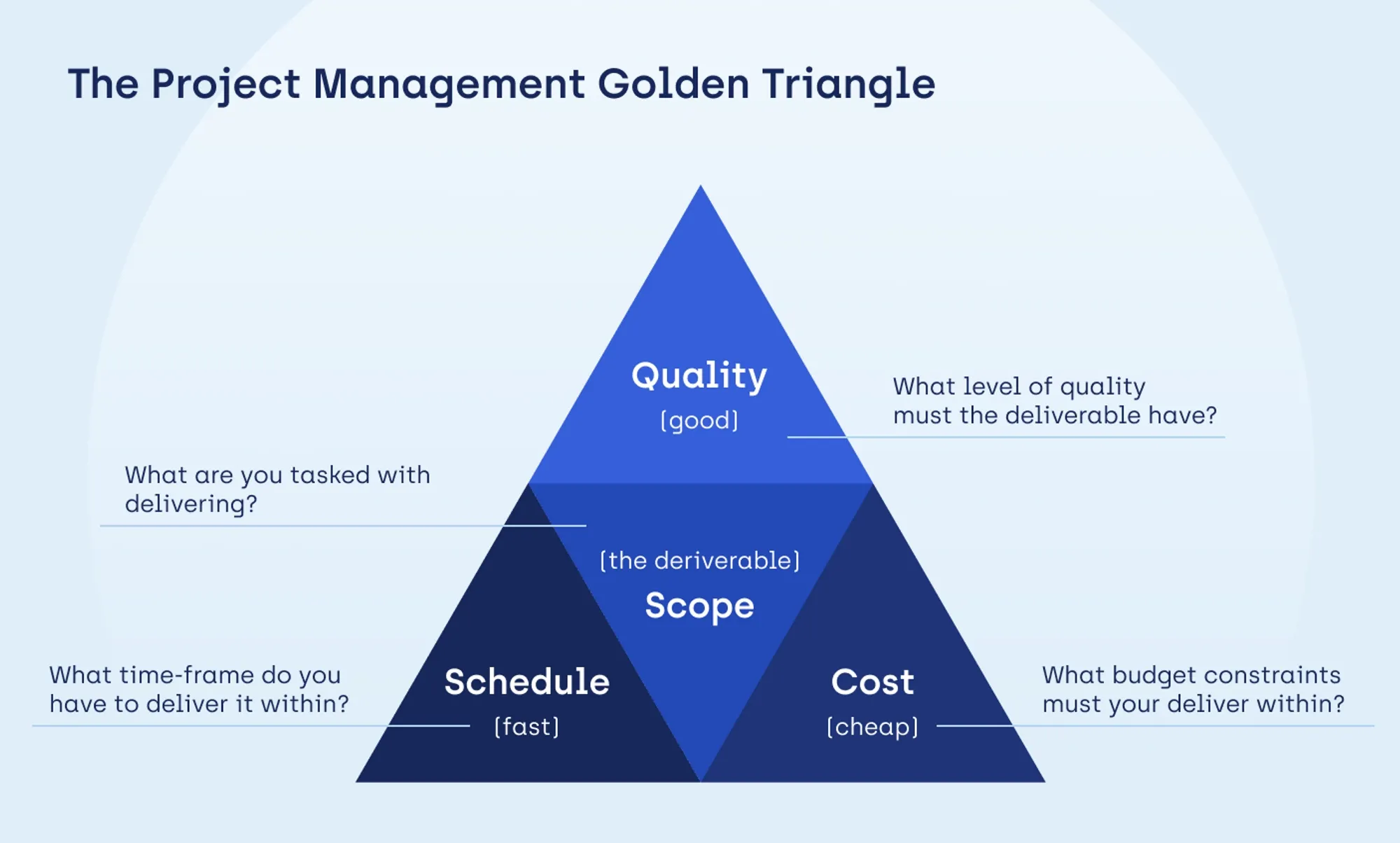
Source of the original version: Mark Warner, TheProjectManagementBlueprint.com
Changing one factor can have a ripple effect on the others. For example, if a project requires high-quality software with advanced features, it may take longer to develop and cost more money. On the other hand, if a project requires a shorter development timeline, it may require additional resources to be completed on time, which can increase costs.
However, before we are able to analyse it, we must understand the project scope, which determines what deliverables contribute to successful software delivery. Failing to understand the project requirements can, in fact, doom the endeavour from the start. Many businesses and IT executives associate project failures with poor requirements gathering, planning and estimation.
What Influences The Cost Estimation of A Software Development Project?
The overall software estimation can include several factors that influence the costs, including:
- Project requirements and scope. The complexity and size of the project, including specific features and functionalities included in the MVP.
- Technology stack and development framework. Some technologies are more expensive than others and may require more specialized skills.
- Complex integrations. Even after a thorough analysis and Proof of Concept, integrations may generate costly errors due to their complexity or potential inaccuracies in the documentation.
- Development team size and experience. A large and experienced team executes projects faster and more efficiently. On the other hand, it might also be more costly.
- Timeframe. The more urgent the delivery and the larger the time constraints are, the larger team (and therefore resources) are required to complete it on the dot and in high quality.
- Unexpected issues and changes. Changes in scope, technology issues, or other unforeseen problems require additional resources to resolve.
- Automation tools, such as continuous integration and delivery (CI/CD) tools, can speed up the development process and reduce the cost of software.
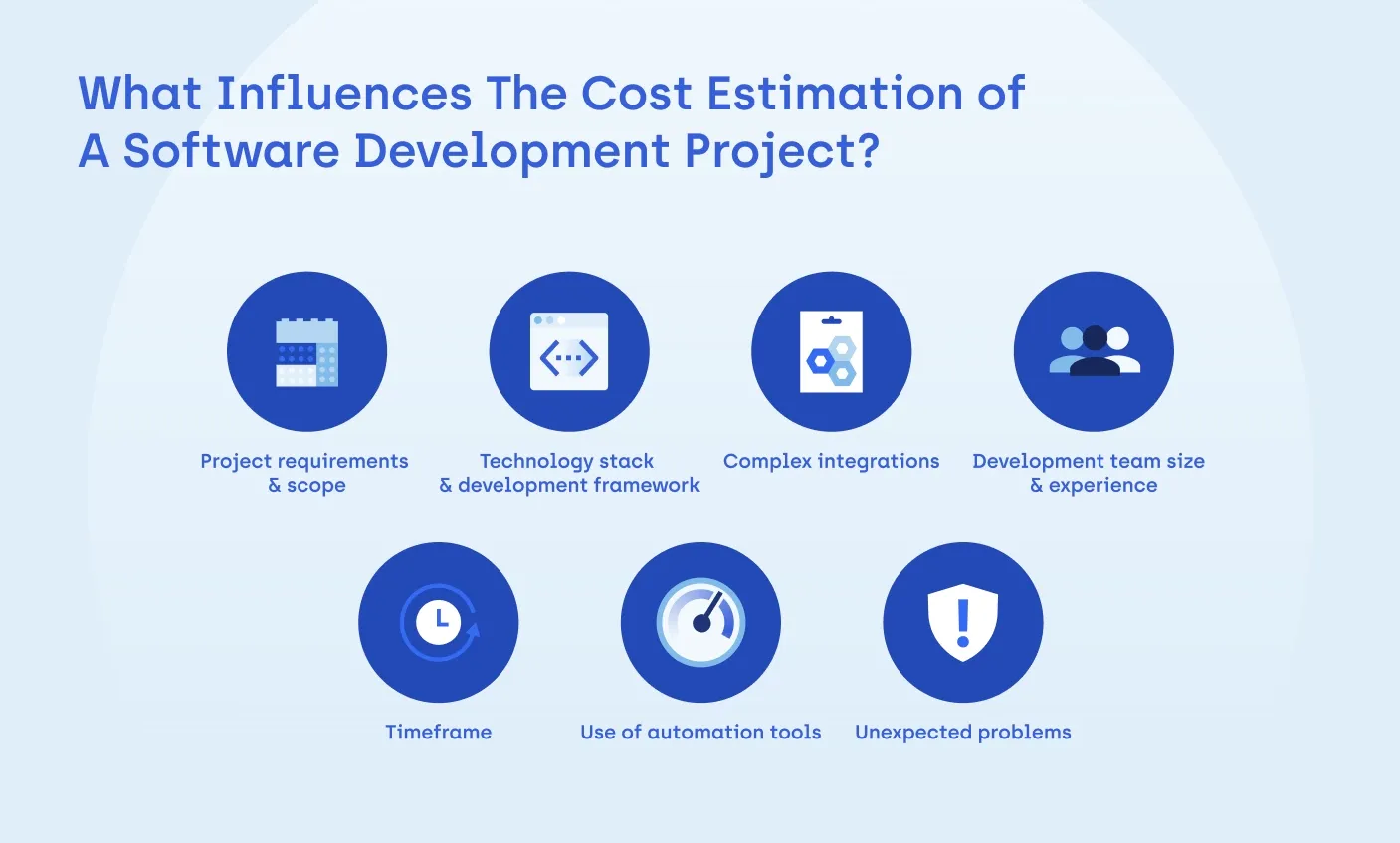

Why Do You Need An Accurate Estimate For Your Software Projects And When Should You Ask For It?
A flawed estimate can potentially result in unfavourable outcomes such as low-quality work, missed deadlines, or overpriced service delivery. On the other hand, when software project estimates are done properly, they can help you evaluate the feasibility and viability of the new challenge, as well as forecast the project scope, budget and timeline. It's also a great risk management tool for making better-informed business decisions.
When to Request a Software Project Estimation?
Consider requesting a software project estimation if you:
- Are in the process of finding a contractor to handle a new project or initiative.
- Want to ensure that the project can be initiated within your budget.
- When identifying potential cost-saving opportunities early in the project and eager to use the estimation to make necessary adjustments.
- Evaluate the feasibility of different project approaches and need an estimation to help you make informed decisions.
- Want to minimize the risk of project cost overruns by getting an accurate estimation of the project's costs upfront.
- Compare and evaluate different contractors' proposals based on their estimated costs, timelines, and approaches to the project.
- Seek funding for a new project or initiative and need to provide potential investors with a detailed business plan and financial projections.
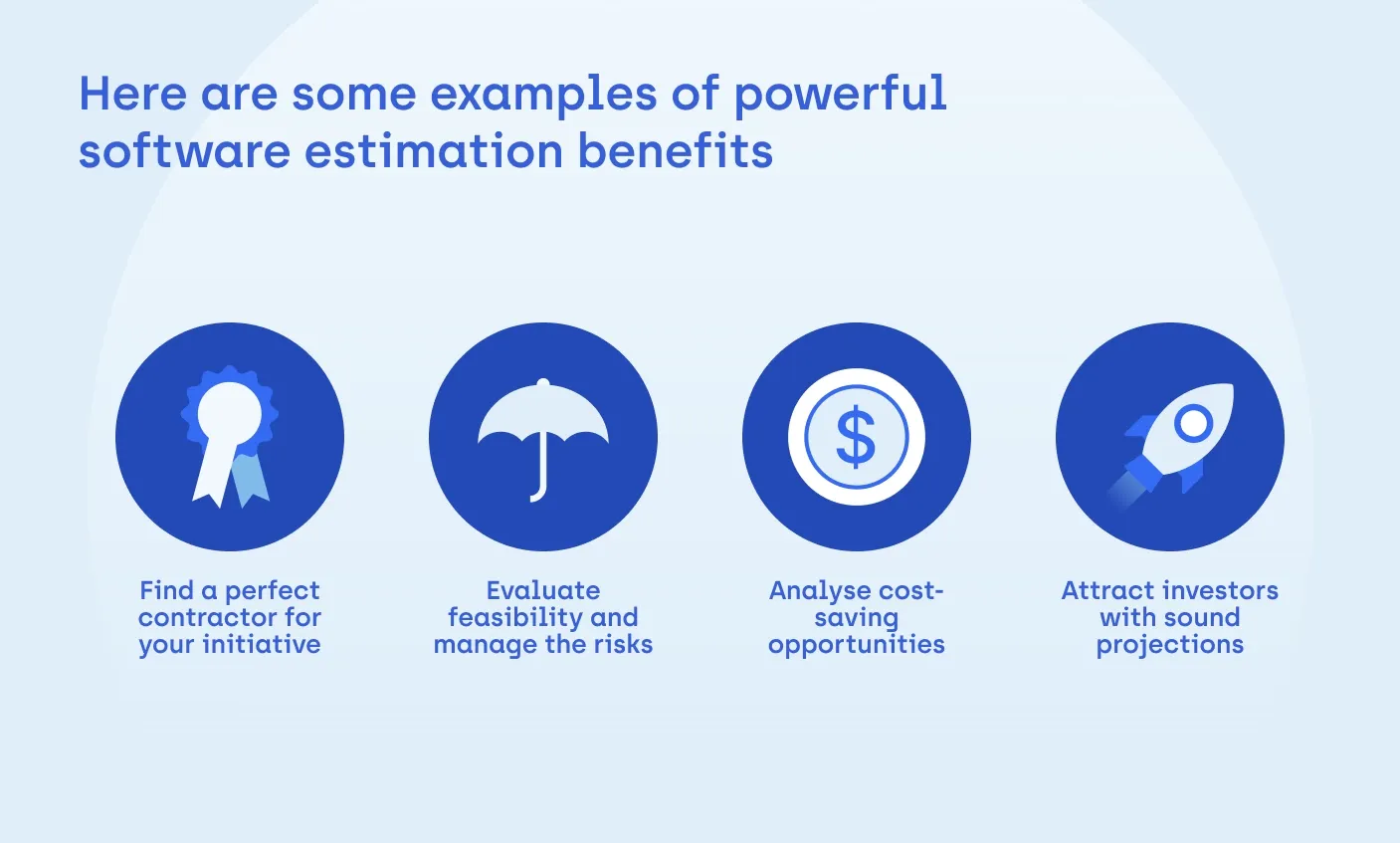
What are the other benefits?
- With an accurate estimate, you first and foremost gain a profound understanding of a software project, allowing you to allocate sufficient funds or resources to it.
- It's also worth identifying and analysing the potential return on investment (or lack thereof) before committing to a project. Software development estimation is crucial in determining whether the endeavour is indeed worth pursuing. Otherwise, it's likely for your company's hard-earned money to go down the drain.
- Just like RFP (Request for Proposal), software project estimation can help you choose the right service provider and negotiate favourable terms with them. So, what's the difference? RFPs are typically more formalized, pertain to a specific product vision, and are commonly utilized in Fixed Price projects
How Do Software Development Companies Approach Cost Estimation?
Estimating software development costs is a critical aspect of project planning. Most software cost estimation processes start with determining the scope. If the scope is fixed, you can estimate time and costs (resources).
Afterwards, companies use various approaches to arrive at a project estimation to ensure that the project aligns with the client's budget and delivers a high-quality end product. It's worth noting that arriving at an accurate estimate is incredibly difficult. Additionally, it hardly ever reflects the actual costs (the amount of money you ultimately spend).
It's also common that estimations for the same software development projects to differ significantly between service providers. For instance, one provider may quote a price of 300.000 USD, while another quotes 1M USD. Interestingly, in a study by Gartner, projects with budgets over 1M USD were 50% more likely to underperform than smaller projects.
To ensure a reliable and accurate software development estimation, companies typically use a combination of different project estimation techniques, such as historical data analysis, expert judgement, and estimation models (amongst many others).
- Historical data analysis involves reviewing past projects to identify patterns and trends that can be used to predict costs for similar projects.
- Expert judgement is based on the knowledge and experience of subject matter experts who provide input on the expected costs and timelines for a given project.
- Estimation models rely on statistical and mathematical algorithms to generate estimates based on various project parameters, such as project size, complexity, and scope.
Moreover, the overall project estimate includes many factors, which can usually be assigned to one of the following categories: project requirements, project execution and project team.

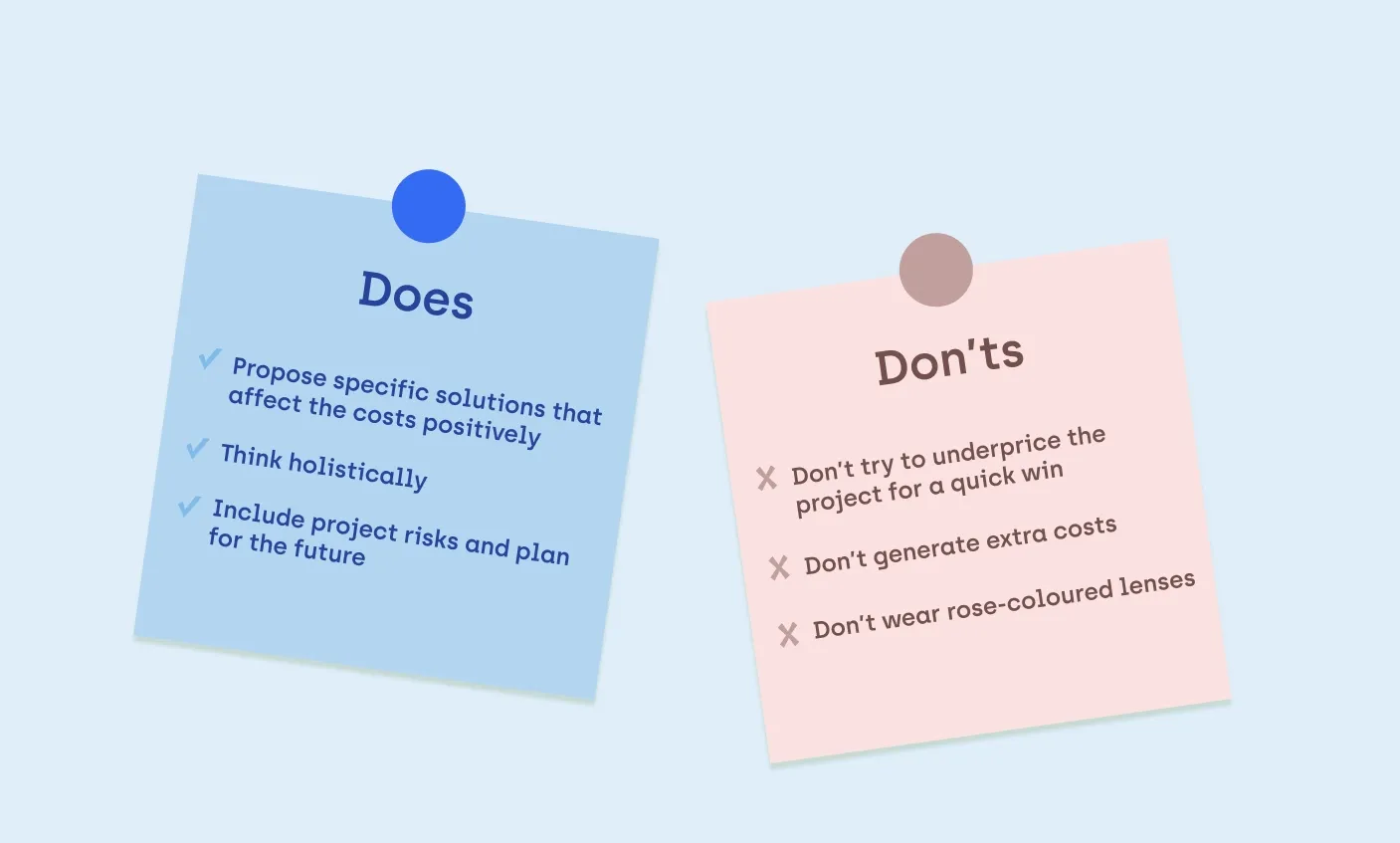
Project Requirements
When developing software, project requirements encompass various features, functionalities, and specifications. It's important to note that the more intricate the requirements, the greater the time and resources required for the development. Factors such as the software's size, level of customisation, and integration with other systems also influence project requirements.
When creating software, it's important to check if the provider includes recommended technologies. It simply shows their dedication to delivering the best possible outcome. Also, our experience has shown that customizing only the necessary parts of the system, rather than creating everything from scratch, can help to reduce costs and simplify project implementation. Therefore, incorporating some pre-existing software solutions may prove advantageous.
Project Execution
Project execution refers to the project management methodology used to develop the software. In Waterfall, costs and time are usually fixed (defined upfront) at the early stages of the project. Most software engineering teams lean more towards Agile development methodologies, which focus on iterative development and allow for adjustments to be made as the project progresses. As a result, estimated costs and timeframes are subject to change during the course of the project.
Agile project teams tend to be more efficient than traditional development methodologies (with a success rate of 61%, according to Project Management Institute), emphasizing collaboration, frequent testing, and rapid iteration.
Some methodologies, such as SPARK, combine the Agile approach with Fixed Costs. However, since this is merely an introduction to software project management, we will save the explanation for another time.
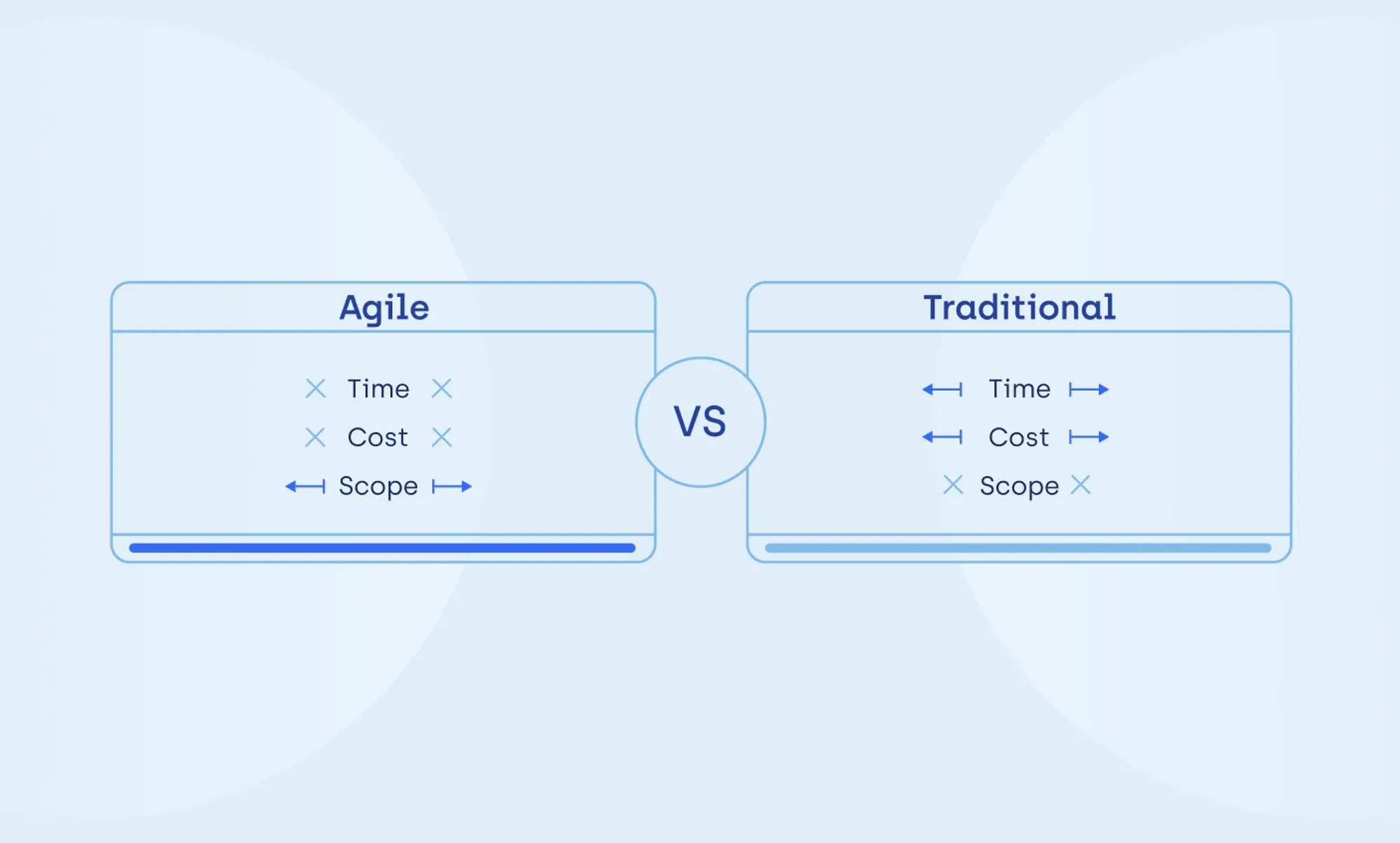 Source of the original version: toptal.com
Source of the original version: toptal.com
Project Team
The software development life cycle involves numerous stakeholders, and their expertise can significantly impact the outcome. A proficient team comprising developers, testers, business analysts, DevOps, UX/UI designers, project managers, and others can ensure an effective development process. Moreover, much depends on the project scope. For example, delivering a simple mobile application requires fewer team members (and less experienced ones) than integration with SAP.
Estimating labour costs is incredibly challenging, while still remaining a significant portion of your overall expenses and one of the main reasons why software project estimations differ significantly. Firstly, they can vary greatly depending on the location, skill level, and experience of the software development teams involved. For example, the hourly rate for a software developer in North America or Western Europe can be significantly higher than in other parts of the world, such as Eastern Europe or Asia.
However, even when you're comparing software project estimations from the same region, they are still affected by the number of roles, the salary of team members involved, and indirect costs (such as rent, training, communication and downtime).
How Do We Calculate It At Hero/dot?
At hero/dot, we use man-days (MD). This term is used in project management to estimating the amount of work that can be done by one person in a single day. Our approach to cost estimates involves calculating the number of man-days committed by each individual (role) involved in the project. This allows us to accurately determine the overall cost of the project.
To simplify pricing, we break it down into rounds, also known as milestones. Each round represents progress towards achieving a specific business goal or functionality within the project. Roles within each round are assigned based on the scope of that particular functionality. For instance, project management roles are assigned separately as they pertain to the project as a whole. At the end of all rounds, the costs are summed up in a spreadsheet for a clear understanding of the overall pricing.
What Is An Accurate Software Project Estimation And How to Evaluate It?
As previously discussed, providing an accurate and ethical estimation for a software project can be a challenging task. IT projects are often subject to internal pressure from stakeholders who want to see results quickly, which can lead to unrealistic expectations and overly optimistic estimates.
Our experience has shown that some companies may underestimate their cost estimates to increase their chances of winning a contract. Why? The cost is a significant factor for businesses when selecting a contractor, and software development companies are fully aware of that.
An accurate estimation is realistic, reliable, and based on sound assumptions, taking into account all the necessary project details.
With that in mind, here are our best tips for evaluating software project estimations.
Tip 1: Are Maintenance And Growth Phase Included?
The software development life cycle doesn't end as soon as you release the product. Rather, it's an ongoing effort. For that reason, you must be able to predict how your product will be handled in the long run. Planning for the growth phase early on and including maintenance or IT support is a sign that the service provider thinks long-term about project success.
Tip 2: Are There Any Risk Estimates?
In software projects, it's also important to take unexpected technical issues into account, as overcoming them requires some extra effort. At hero/dot, we include project risk estimates from the get-go. By pointing out what may go wrong (based on our development team's experience), the client can better assess and manage the pain points. For example, integrations are a big conundrum in most projects.
To accurately determine the capacity, it is necessary to thoroughly review the documentation, conduct a Proof of Concept, and analyze the results. However, even with these steps, there may still be unforeseen issues. Possible errors may arise due to the complexity of integration and potential inaccuracies in the documentation.
By pointing out what may go wrong (based on our development team's experience), the client can better assess and manage the pain points.
Tip 3: Do They Propose Ready-Made Solutions?
Beware of overcharging! When estimating software projects at hero/dot, we pay attention to how the costs could be alleviated. Writing a custom application that offers the same components as commercially available software solutions misses the point and is much more expensive. If there is no mention of ready-to-integrate solutions in the offer, a red light may go on for you. The project's success may cost you an arm, but not a leg.
Tip 4: How Does The Contractor Propose Technologies?
Did the estimation propose specific software solutions? If yes, that's a good sign. Decisions about the technology stack or development framework must be relevant to the client's budget. For example, if the project scope includes developing a mobile application for iOS and Android, the software provider can recommend cross-platform frameworks, such as Flutter or React Native.
Tip 5: Is Effort Estimation Included?
Labour and manpower are a significant portion of the actual cost. The software project estimation process may include effort estimation, which relates to the manpower that a development team needs to put in to reach the finish line. It also depends on the complexity and scope of a project, experience and skills, as well as the availability of resources (hardware, software and other complex tools).
Tip 6: Does The Software Project Estimation Sound Overly Optimistic?
We would advise you to stay cautious when the software project estimation sounds overly optimistic. That includes unreasonably short timelines or underpriced offers. Looking for a reliable partner who can handle the complexity of your project when times get rough? Beware of short-sighted experts that might leave you high and dry.
Conclusion
Precise project estimation is essential to bring your software development plan to fruition. It allows you and your software company to align the project scope, budget, timeline and resources in a well-planned manner.
However, this is not a task for amateurs as it requires expertise and experience to produce accurate outcomes. Incompetent estimations can lead to unsatisfactory results. That's why it's vital to entrust this responsibility to a qualified professional who knows the ins and outs of the software development industry. Luckily for you, hero/dot has got you covered with expert business analysts at your disposal!
Need expert assistance with your digital project?

